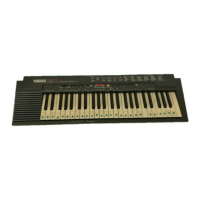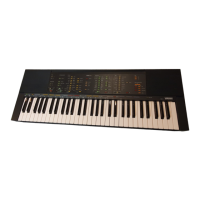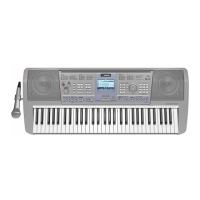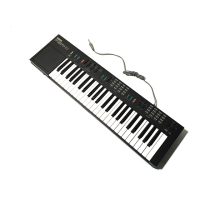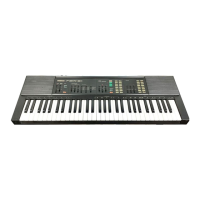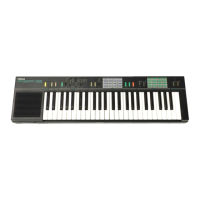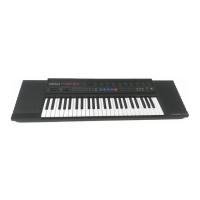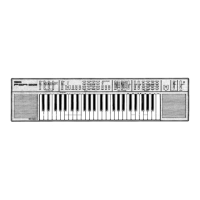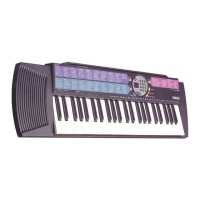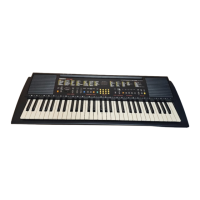
Do you have a question about the Yamaha PortaTone PSR-82 and is the answer not in the manual?
| Brand | Yamaha |
|---|---|
| Model | PortaTone PSR-82 |
| Type | Electronic Keyboard |
| Number of Keys | 49 |
| Voices | 100 |
| Rhythms | 100 |
| Effects | Reverb, Chorus |
| Display | LCD |
| Power Supply | AC Adapter or Batteries |
| Power Consumption | 12W |
| Connections | Headphones |
| Amplification | Built-in |
Information on using batteries or an AC power adapter for the instrument.
Instructions on how to attach the music stand to the instrument.
Guidelines for keeping the instrument in good condition, including location and cleaning.
Explanation of the automatic power-off feature to conserve battery.
Instructions for connecting and using the AC power adapter.
Diagram and labels for the top panel and rear connectors of the PSR-82 model.
Diagram and labels for the top panel and rear connectors of the PSR-83 model.
Detailed descriptions of all buttons and controls on the instrument's top panel.
Description of all input and output jacks located on the rear panel.
Steps to turn on the instrument and set the master volume level.
Methods for choosing instrument sounds using numeric buttons or increment/decrement.
How to play notes on the keyboard, including the touch response feature.
Using the keyboard to play drum sounds when the DRUMS voice is selected.
How to use the Sustain effect to make notes decay gradually.
Feature for playing two voices simultaneously on the PSR-83.
Shifting the keyboard pitch up or down by semitones.
How to select the Split mode using the MODE button.
Procedure to define the keyboard split point for left/right hand voices.
How to choose different voices for the left and right sections of the keyboard.
Methods to choose from 50 accompaniment styles using numeric buttons or increment/decrement.
How to adjust the tempo of the accompaniment using TEMPO buttons.
Using START/STOP or SYNCHRO START/ENDING buttons to begin playback.
Using INTRO/FILL IN for patterns and rhythm variations during playback.
Methods to stop accompaniment playback using START/STOP or SYNCHRO START/ENDING.
Using ACCOMPANIMENT VOLUME buttons to balance with melody.
How to create simple accompaniments using single finger chordings.
Defining the keyboard split point for single finger mode.
Fingering techniques for playing specific chord types in single finger mode.
Using the Fingered mode for playing custom chords for accompaniment.
Defining the keyboard split point for fingered mode.
Explanation of the 5 different auto harmony types available.
Instructions on how to record chord sequences into memory banks.
How to play back recorded chord sequences from individual banks.
How to program and play back sequences of multiple banks.
Default chord memory bank and chain data provided with the instrument.
How to select and play the 15 built-in demonstration songs.
Feature to play songs with the melody line removed for practice.
Explanation of MIDI as a digital musical instrument interface.
Description of the MIDI IN and OUT ports on the PSR-83.
How MIDI OUT transmits data and can control other devices.
How to select and operate the PSR-83 in Remote Control mode.
How the PSR-83 transmits MIDI data in Remote Control mode.
How the PSR-83 receives MIDI data in Remote Control mode.
Using the PSR-83 as a tone generator receiving data on multiple MIDI channels.
Setting the MIDI receive and transmit channels for Multi mode.
Addresses 'pop' sound when powering on/off, stating it's normal.
Troubleshooting steps for when no sound is produced by the instrument.
Troubleshooting for issues with starting rhythm or auto accompaniment.
Troubleshooting for accompaniment chord recognition and key changes.
Diagnosing and fixing sound distortion or intermittent output.
Addresses minimal sustain effect and general operational problems.
Details on keyboard, voices, styles, controls, jacks, power, dimensions, and weight.
Illustrations and fingerings for various major chords.
Illustrations and fingerings for various minor chords.
Illustrations and fingerings for various seventh chords.
Illustrations and fingerings for various minor seventh chords.
Illustrations and fingerings for major seventh chords.
Illustrations and fingerings for minor major seventh chords.
Illustrations and fingerings for augmented chords.
Illustrations and fingerings for diminished chords.
Illustrations and fingerings for suspended fourth chords.
Illustrations and fingerings for minor seventh flatted fifth chords.
Illustrations and fingerings for minor sixth chords.
Illustrations and fingerings for seventh suspended fourth chords.
Illustrations and fingerings for seventh flatted fifth chords.
Musical score and details for the song 'Original Theme'.
Musical score and details for the song 'Sing'.
Musical score and details for 'Happy Birthday to You'.
Musical score and details for the song 'Spring'.
Musical score and details for the song 'Carmen'.
Musical score and details for 'Grandfather's Clock'.
Musical score and details for the song 'Minuet'.
Musical score and details for the song 'Something'.
Musical score and details for 'House of the Rising Sun'.
Musical score and details for the song 'Edelweiss'.
Musical score and details for the song 'La Cucaracha'.
Musical score and details for the song 'Amaryllis'.
Musical score and details for the song 'O, Vreneli'.
Musical score and details for the song 'Greensleeves'.
Musical score and details for 'We Wish You a Merry Christmas'.
Details MIDI data transmission and reception for remote control.
Details MIDI data transmission and reception for multi mode.
Yamaha's right to modify specifications and general product notices.
Caution about potential hearing damage from high volume levels.
Details FCC Part 15 compliance and interference mitigation.



